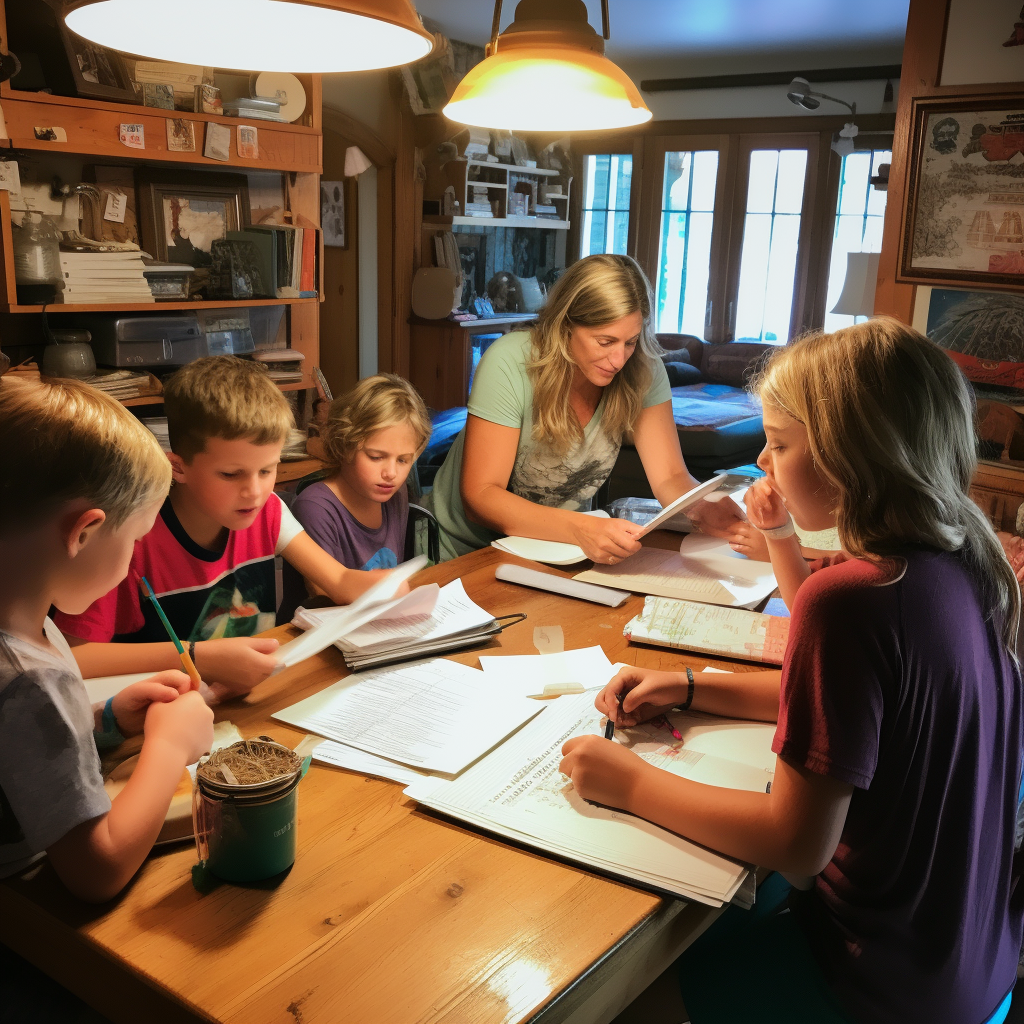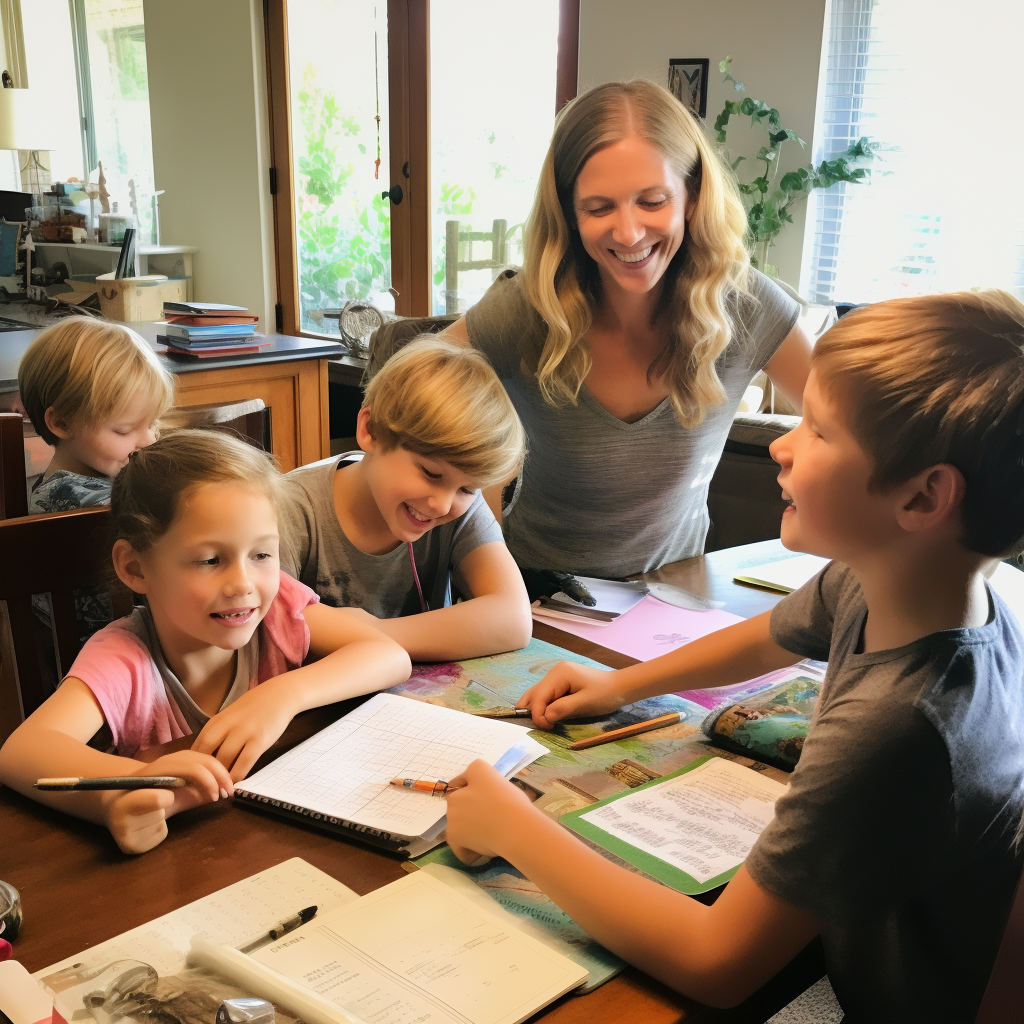Scheduling homeschooling for multiple children of different ages requires careful planning and organization. Homeschooling allows parents to customize their curriculum according to the individual needs of each child, while also allowing them the flexibility to accommodate their work and other commitments. Having a well-structured schedule is essential to ensuring that all of your children can benefit from the homeschooling experience. This schedule should include breaks for kids to take time off from their studies, allowing them to participate in activities, hobbies, and other creative outlets. It should also factor in time for independent work, group activities, and family time, so that parents can have meaningful interaction with each of their children. Additionally, it’s important to remember to be flexible and willing to adjust as needed when unexpected changes arise. With thoughtful consideration and a well-planned schedule, you can help each of your children to have a successful and rewarding homeschooling experience.
Defining what it means to homeschool
Homeschooling is an education model in which parents, or guardians, assume responsibility for the educational instruction of their children in lieu of enrolling them in formal schools. Homeschooling can provide a customized education tailored to the learning style, interests, and academic needs of the individual children.
When scheduling homeschooling for multiple children, especially those of different ages, it is important to consider the individual learning styles and interests of each child. Parents should be prepared to divide their time and resources among the children in an equitable way, customizing projects and activities as necessary to accommodate different ages and abilities. It is beneficial to create a flexible homeschool routine that works for everyone in the family and allows for enough freedom and exploration. When creating a routine, consider incorporating blocks of time dedicated to individual subjects or activities as well as group projects and activities. For example, school-aged children can work on academics in the morning, and then come together for learning activities or projects in the afternoon. Younger children can also have their own activities and lessons planned for the day, while joining the family for the group activities. Flexible scheduling also allows for downtime for the children and the adult educator to reenergize and use additional resources. Overall, maintaining a flexible, equitable, and inspiring homechool routine that best suits the family’s goals and lifestyle is key to successful homeschooling.

Explaining why organizing a homeschool plan can be particularly challenging for a big family
Organizing a homeschool plan for a big family can be particularly challenging because each child has different needs. Additionally, even siblings often have different learning styles, abilities, and interests. As such, it is important for parents to take the individual needs of each child into consideration when planning a homeschool schedule.
Creating a flexible schedule that accommodates all the different ages and abilities of the children can be a difficult task. Some ideas that can help in the planning process include defining the subjects being taught, such as core academic areas, extracurricular activities, and any required special education services; coordinating activities across multiple children so that siblings and children of different ages can do tasks together; incorporating learning activities that are tailored to each child’s individual interests and abilities; and setting up a schedule that is feasible for the family and allows for rest.
Finally, parents should also ensure that their homeschool plan allows for balance between work and play, and provide regular breaks throughout the day. By taking all of these factors into consideration, parents can create an effective and enjoyable learning experience for their big family.
Tips for Creating an Overall Flexible Schedule
1. Start with Scheduling Core Subjects: Depending on the ages of your children, many core subjects can be scheduled together. Create a block of time for each of these core subjects and include reading, math, science, and social studies and any other core subjects that are relevant.
2. Synchronize Electives: Electives like music, art, and physical education can be scheduled in tandem. Find activities that can be enjoyed by all children and schedule for one specific time period when all your kids work together.
3. Personalize Learning: Different students may require different learning styles and course selections. To cater to this, create flexible time blocks for each child, allowing them to work on different subjects or activities as needed.
4. Leave Scheduling Open For Creative Projects: Make sure to allow for some flexible time for all your children to do creative projects. This will encourage creativity and allow your children to find fulfillment in their learning.
5. Swim in or Surf out: Make sure to include a lot of time for the family to swim, surf, or get outdoors. The focus of homeschooling should be to deepen connections and foster family dynamics. Outdoor activities and time together is essential for homeschool success.
Scheduling overlapping activities
Scheduling overlapping activities for homeschooling multiple children of different ages can be done through careful planning and communication. Plan out each day and week, assigning certain classes or activities to each child that they can work on simultaneously. Make sure to create time for siblings to work together on some activities or to have dedicated time just for each child. Have check-ins with your children during the day to assess how they are doing and if they need any assistance. Finally, make adjustments throughout the week as needed to ensure everyone is on track.

Breaking down the day into manageable blocks
Breaking the day into manageable blocks is a great way to help ensure no one gets overwhelmed or tired when homeschooling multiple children of different ages. Examples of blocks for homeschooling could include:
1. Morning Block – This could include any morning activities that all family members partake in, like morning stretches, reading aloud, discussing the day ahead, meditation/mindfulness etc.
2. Academics Block – As children have different learning objectives and needs, here parents could separate each child into their own academic groups. Within these subject blocks parents can create lesson plans that cover the appropriate subject matter suited to each child’s age and level.
3. Activity Block – Here everyone could partake in activities such as science experiments, arts and crafts, cooking, and physical activities such as walks, sports, yoga. These activities encourage children to have a break and also bond with family members.
4. Technology Block – Here parents can let children have some screen time such as educational apps, web surfing etc. Parents need to monitor to ensure children are staying safe online.
5. Final Block – To conclude the day, parents can reflect on the day’s activities. Here they can discuss what was learned, observed, enjoyed or struggled with. This is also a good place to unwind from the day and prep for the evening.
Allowing for downtime
Allowing for downtime in a homeschooling schedule for multiple children of different ages is important for the overall well-being of the family and each individual student. It’s important to create a schedule which provides a balance of learning and rest. This could mean scheduling rest times for certain children so they have time to relax or reset, as well as providing dedicated time to spend time together as a family. Having built-in time for family activities, meals, games, nature walks, or other activities can help create a better balance that encourages learning. It can also help ensure that each child is able to progress in school and learn without becoming too overwhelmed or burnt out from their workload. Additionally, allocating extra time for catching up on school assignments can help minimize stress and create a healthier and more pleasant learning atmosphere for all.
Setting Up Individualized Schedules
Setting up individualized schedules for multiple children of different ages in a homeschooling setting is a great way to ensure that all students have enough time to focus on their studies and complete assignments. It can help keep them organized and prevent them from becoming overwhelmed with too much work at any given time. When creating individualized schedules for each child, parents should take into account their age, learning style, and learning needs. Schedules should also reflect their individual interests and goals, and should provide opportunities for collaboration with siblings.

Some tips on creating individualized schedules for multiple children in a homeschooling setting include:
• Split the day into organized blocks of time for each subject.
• Allow for some overlap in the morning and afternoon. This gives siblings time to share ideas and collaborate on projects.
• Identify when each student will have some choice time—maybe an hour in the middle of the day—to pursue their own interests or to delve deeper into a particular topic.
• Take breaks throughout the day and get out into nature. Fresh air and physical activity are important and beneficial for learning.
• Offer flexibility. It’s ok for siblings to switch topics throughout the day or work on different tasks during the same time.
• Give your children opportunities to teach each other—they might teach each other a foreign language or a skill such as coding.
• End the day with a
Comparing the needs of each child
When scheduling homeschooling for multiple children of different ages, it is important to take into account each child’s individual needs and learning styles. For example, an older sibling may need more guidance and practice to keep their skills sharp, while a younger sibling may require shorter lesson times and more independent study. Furthermore, some children may require more one-on-one attention and hands-on activities than others. Additionally, each child may have different academic interests and special needs that need to be catered to. Taking these needs into account when designing a schedule can help ensure that each child has the resources and environment they need to excel.
Prioritizing the importance of certain activities
Prioritizing activities when homeschooling multiple children of different ages is essential. It is important to make sure that each child is given the academic instruction they need for their age level while ensuring that their learning is balanced with activities such as physical education, social skills, arts and crafts, and other experiences that will build a strong foundation.
It is important to keep track of each child’s progress and make adjustments as needed to ensure that their individual needs are met. Additionally, it is important to create a schedule that allows for flexibility for activities such as outdoor play, field trips, or other family activities, as these can add additional learning opportunities for your children. Additionally, be aware of different ways your children may learn best and tailor instruction accordingly.
Finally, it is important to remember to take breaks throughout your homeschooling day. Habits such as reading time, lunch breaks, and outside time can help keep kids engaged and provide a much needed break from learning and academics.
Scheduling in structure and planning ahead
Scheduling homeschooling for multiple children of different ages requires careful structure and planning ahead. To ensure that all your children get a quality education, it is important to create an organized plan for the school year that looks at what each child needs to achieve on a daily, weekly, and monthly basis. Some of the questions you should ask yourself when creating your plan include:
• What will each child learn in each subject?
• What curriculum will be used?
• What are the due dates for assignments and tests?
• How will I measure each child’s progress?
• What sources can I use to supplement learning?
• How can I create a balance between instruction and playtime?
• How will I keep track of important dates and materials?
Once you have created the homeschool structure and plan, be sure to stay organized. Assign each child their own workspaces, establish daily routines, keep track of important dates and materials, and most importantly, prepare and plan ahead as much as possible. Taking the time to create a structured schedule and plan for success will ultimately lead to an organized, effective, and successful homeschooling experience.
Organizing Indoor and Outdoor Activities
Organizing activities for multiple children homeschooling at different ages can present challenges. Indoor activities can involve using different types of media such as videos, computer games, or online resources. You can also create virtual field trips and ask children to take photos of interesting discoveries. Outdoor activities can include walks, hikes or bike rides to enhance their knowledge of the local environment. Games incorporating physical activity such as hide-and-seek or guided treasure hunts can help children to explore their outdoor learning environment. When organizing activities for multiple children of different ages, it is important to consider everyone’s interests, learning styles, and abilities. Create a plan that maximizes educational opportunities, stimulates imagination, and increases physical activity. Schedule time for breaks and free play to ensure each child gets a chance to rest and refresh.
Utilizing the space available
Scheduling homeschooling for multiple children of different ages can be a daunting task. It is important to make sure that the available space is used judiciously. First, it is necessary to assess the available space in order to create a plan that works for all family members. This could involve separating rooms or areas into learning zones for different age groups or dedicating certain times of day to individual subjects.
Once the space is determined, it is important to create a schedule that fits within the available rooms or areas. This should include block times for various subjects and activities that cater to each child’s individual needs. Additionally, ensure that there is flexibility in the schedule so that family members can be available to support each other. Finally, make sure that there is time for breaks and fun activities so that the school day doesn’t become too monotonous and overwhelming.

Taking advantage of resources at home
Scheduling homeschooling for multiple children of different ages can be a daunting task, but taking advantage of resources at home can make the process much easier. One way to do this is to create a flexible schedule that caters to each of your children’s individual needs and interests. Take time to research the different types of instruction and learning styles that work best for your children’s ages to help tailor the homeschooling experience to each child. Utilizing online resources for home learning can be extremely helpful. There are a plethora of websites, YouTube channels, and apps with educational content specifically tailored for different age groups and subjects. Additionally, making use of extra materials like library books or magazines can also be incredibly beneficial. Having multiple children at home can provide plenty of playtime opportunities where they can learn independently from one another, which can help to ease some of the pressure of teaching multiple children at the same time. Finally, don’t be afraid to reach out for help from family members, friends, or online support networks.
Exploring local educational opportunities
Exploring local educational opportunities can mean researching different homeschooling providers or enrolling in a local public, private, or charter school for in-person or remote instruction. It can also mean connecting with other parents in the community to form “pods” that offer both in-person and virtual instructional options.
When homeschooling multiple children of different ages, it is important to consider each child’s learning style and needs to create an individualized schedule that provides options for each student. Work with each individual child to identify a scope of educational goals that accounts for each child’s interests, strengths, and weaknesses. Also, take into consideration the amount of time available to complete home school instruction since younger children may not be able to complete the same amount of instructional work as older students.
Try to provide a variety of activities that accommodate the needs of each child. You can provide tuition-based online classes to complement homeschooled subjects. Or if the children have a natural curiosity and motivation to learn, look into taking courses at a local community college.
For parents trying to juggle homeschooling multiple children of different ages, ensure that you factor in time for yourself and the children to rest and take breaks throughout the day. Package fun learning activities such as virtual field trips, audio story-telling, or watching educational television. Also, schedule enjoyable learning activities such as outdoor recreation and quality family time.
Staying Up to Date with Homeschool Documents (for State Compliance)
When homeschooling multiple children of different ages, staying up to date with homeschool documents for state compliance can be tricky. To make sure you comply with all state–specific regulations, you’ll need to create individual homeschool plans for each child. These plans should include details about the materials used, the curriculum and activities for each subject, the teacher’s qualifications, and the evaluation and assessment methods for each student.
You can also use online tools to keep track of your homeschooling schedules and document the progress of each student’s homeschool program. This will make it easier to ensure your students are receiving the education they need to pass state testing requirements at the end of each school year. Additionally, you can set up a home-based learning center with individual learning spaces for each student. This will help create a learning environment where each child can focus and thrive. Regularly checking in with each student’s progress can help make sure they’re staying on track and engaged in their studies.
Keeping track of attendance
Keeping track of attendance in a homeschooling setting is especially important because it will serve as proof of the number of hours each of your children have learned. This is important in the case of homeschooling for multiple children of different ages because you may need to alter the curriculum and/or the scheduling of lessons for each individual child. Keeping track of attendance can help ensure that each child is on track with their individualized learning plan. Some tips for tracking attendance include recording the date and time each child started and completed their assignment in a homeschool journal, using an online platform to keep track of attendance (ex. Google Classroom), or setting up an online or physical attendance sheet that records the dates and times each child participates in learning activities.
Recording lesson plans
In the context of scheduling homeschooling for multiple children of different ages, recording lesson plans is essential. For each of the children in your homeschool, you should have a lesson plan document that clearly lists the activities and topics you will be covering each day and how long you will be spending on each one. consider including details in each lesson plan such as the specific subject and curriculum being used, the main skill or objectives for each activity, the accompanying materials needed, and any additional instructions.
These lesson plans should also take into account the age and learning level of each child, as well as any individual educational goals or needs for each. Make sure to include various learning strategies and activities, such as providing hands-on experiences, discussing the material in a way that is understood by the child, and relying on technology-based tools to encourage independent learning for older children. To make the most of the time, you can schedule common activities for multiple children and then have one-on-one time with each one for targeted instruction that addresses their individual needs. It is also helpful to break up activities and breaks into regular increments so you can get the most out of the day and maintain the focus.
Recording the lesson plans and keeping them updated allows you to effectively manage both the teaching workload and the learning objectives you have set for each child. By having these plans on hand, you can easily adjust as needed to ensure that all your students stay on track.
Consulting with local and state organizations
Consulting with local and state organizations can be a great way to get started exploring your homeschooling options for multiple children of different ages. Depending on the state you live in, there may be local and state organizations that provide resources and support for families who are homeschooling. These organizations may offer programs tailored to different homeschooling approaches, as well as legal advice, curriculum resources, and activities for families to participate in. Additionally, they can direct you to other homeschooling support networks that may be specific to your area or the ages of your children. Scheduling homeschooling for multiple children of different ages can be a daunting prospect; however, with the guidance and advice of local and state organizations, you may find the ideal solution for your family’s needs.
Conclusion
Scheduling homeschooling for multiple children of different ages can be a challenge but it can be done. By creating an organized system and building in time for flexibility, you can create a successful homeschooling plan that meets the needs of your entire family. Educating children of multiple ages simultaneously involves engaging each child in age-appropriate activities while finding ways for them to work together. You may find that siblings can take turns working on assignments, completing workbooks, doing physical activities, or attending virtual classes. A hybrid approach can also be used so that there are days spent at home and other days where there are visits to museums or virtual field trips. Variety and engagement are key components of a successful homeschooling plan.
How to make necessary adjustments as needed
When scheduling homeschooling for multiple children of different ages, there are a few important adjustments to consider. First, ensure that the curriculum for each child is appropriate for their age and learning level. For younger children, it may be beneficial to have visuals or other activities that help explain concepts in a more engaging way. Additionally, it may be helpful to allot different windows of time for different children so that each one can focus on their work without being interrupted, while also not blocking the others from having their own chance to learn and read. Finally, it’s important to think about how the schedule can be flexible. This can involve allowing for breaks or moments to take on tasks of the child’s own interest, such as collaborating with a sibling on a project or reading an unrelated book.
Benefits of taking the time to create a schedule
Having a schedule in place for homeschooling multiple children of different ages can be incredibly helpful in establishing structure and routine for the day. A schedule can provide structure and clear expectations for each day, as well as help prioritize activities in order to make sure that each child gets the attention they need in order to learn the material. It also allows children to plan their day, giving them a sense of control that can lead to increased motivation and productivity. Additionally, having a schedule in place can make it easier for parents to delegate tasks and better coordinate family activities, as well as track progress and stay on top of deadlines. Additionally, by setting clear expectations and providing structure, a schedule can help parents be more organized and establish better communication between family members.
Reminding readers to be flexible and understanding when unexpected things happen
It’s important to remember that when homeschooling multiple children of different ages, plans will not always go as expected. Unforeseen events happen, and it’s important to be prepared to be flexible and understanding. For example, if one child needs extra help or becomes overwhelmed with the material, it may be necessary to adjust the schedule to accommodate them. Likewise, if there are scheduling conflicts, such as family outings or extracurricular activities, the homeschooling schedule should be given the flexibility to accommodate them. It’s also helpful to remember that some days may require different lengths for different subjects. Some days may require more time engaging with science or math, while other days may require more time for reading or language arts. Being flexible and understanding when something unexpected comes up can make the homeschooling process easier and more enjoyable for everyone.
